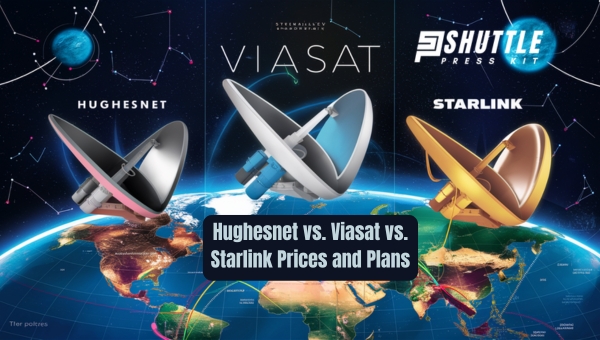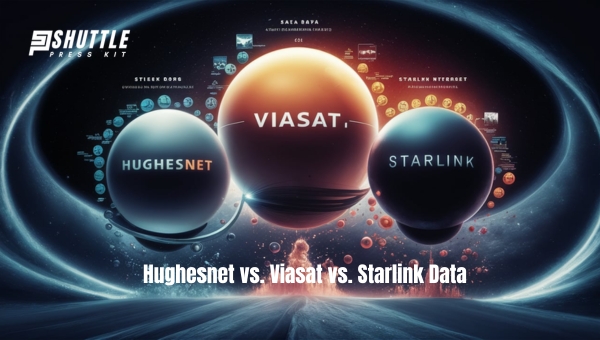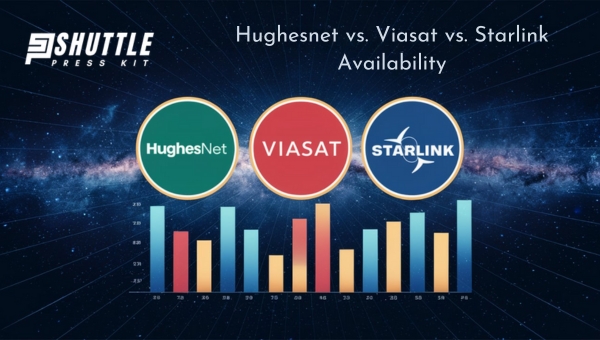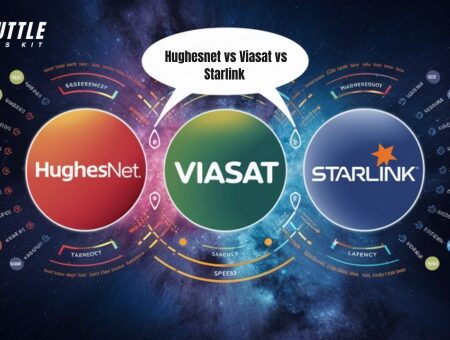When it feels like the whole world is online, picking the right internet provider can be crucial! Today, we are going to dive deep into comparing Hughesnet vs. Viasat vs. Starlink – the big names in satellite internet.
If you’ve ever found yourself scratching your head, wondering which one will give you the best bang for your buck, stick around! This showdown might just have all the answers you’re looking for.
Choosing Hughesnet vs Viasat vs Starlink mainly boils down to what you value most: speed, reliability, or price. Starlink leads in speed with its cutting-edge technology promising high-speed internet even in remote areas.
Hughesnet and Viasat offer plans that can be more budget-friendly and provide reliable service with broader coverage areas. So depending on your top priority – speed or cost – your best pick might vary!
| Feature | HughesNet | Viasat | Starlink |
|---|---|---|---|
| Monthly Price | $49.99 – $94.99 | $100 – $400 | $120 – $250 |
| Speed Range | 25 – 100 Mbps | 12 – 100 Mbps (up to 300 Mbps in some areas) | 25 – 220 Mbps |
| Data Cap | Unlimited | 12 GB – 150 GB (varies by plan) | Unlimited |
| Latency | 600 ms (approx.) | 600 ms (approx.) | 25 – 60 ms |
| Contract Requirements | 24-month commitment | 24-month commitment | No contract required |
| Equipment Costs | $299.99 (purchase) / $14.99/mo (lease) | $299.99 (purchase) / $9.99/mo (lease) | $599 upfront |
| Best For | Basic internet needs in rural areas | Higher speed options in rural areas | High-speed, low-latency internet in underserved areas |
| Additional Features | VoIP available | VoIP available | Mobile internet options available |
Hughesnet vs Viasat vs Starlink
HughesNet, Viasat, and Starlink are the leading satellite internet providers in the U.S., each with unique offerings. HughesNet is known for its affordability, with plans starting around $50 per month and speeds up to 100 Mbps, making it a solid choice for budget-conscious users.
Viasat, on the other hand, provides faster speeds, reaching up to 150 Mbps, and offers unlimited data plans, appealing to those needing more robust internet for streaming and gaming.
Starlink, the newest entrant, boasts the highest speeds, up to 220 Mbps, but at a higher price point, around $120 monthly. While all three providers offer nationwide coverage, the best choice depends on individual needs, including speed requirements and budget constraints.
Also Read: Amazon’s Project Kuiper vs Starlink: Showdown Unpacked
Prices and Plans
When comparing the pricing structures of HughesNet, Viasat, and Starlink, notable differences emerge that cater to various consumer needs. HughesNet offers a range of plans starting at $49.99 per month for speeds up to 50 Mbps, with its highest tier, the Fusion plan, costing $94.99 per month for speeds up to 100 Mbps.

All HughesNet plans come with unlimited data, but they require a 24-month commitment and often involve additional equipment fees, which can be around $299.99 for purchase or $14.99 per month for leasing. This straightforward pricing model makes HughesNet an attractive option for users seeking basic internet access in rural areas.
Viasat, on the other hand, presents a more complex pricing structure that can start as low as $69.99 per month for speeds up to 12 Mbps, but can escalate to $199.99 per month for higher-tier plans that offer speeds up to 150 Mbps. Viasat’s plans include options with unlimited data, such as the Viasat Unleashed plan, which starts at $99.99 per month.
Unlike HughesNet, Viasat often has promotional pricing for the first few months, but the costs can increase significantly after the promotional period ends. Starlink offers a different approach, charging a flat rate of $120 per month for internet service, with a substantial upfront equipment fee of $599.
Data
HughesNet, Viasat, and Starlink offer varying speeds and data options that cater to different user needs. HughesNet provides maximum download speeds of up to 100 Mbps, but average user speeds tend to be lower, around 17.44 Mbps due to factors like network congestion and latency, which can reach up to 650 ms.

While HughesNet offers unlimited standard data, it imposes a priority data cap ranging from 100 GB to 200 GB depending on the plan, after which speeds may slow during peak usage times.
In contrast, Viasat offers download speeds between 12 Mbps and 150 Mbps, with some plans reaching up to 300 Mbps. Viasat also provides unlimited data, but users may experience throttling if they exceed a certain threshold, typically around 850 GB per month.
Starlink stands out with speeds ranging from 25 to 220 Mbps and also offers unlimited data without hard caps, although it may slow down during periods of high usage. This combination of speed and data flexibility makes Starlink particularly appealing for users with high bandwidth needs.
Availability
Hughesnet, Viasat, and Starlink are the three major satellite internet providers in the United States, each offering service to nearly 100% of the country.

However, their availability and coverage differ:
- Hughesnet is available in all 50 states, Puerto Rico, and Alaska, as long as there is a clear view of the southern sky. It offers speeds up to 100 Mbps.
- Viasat is also available in all 50 states and some international areas, including Puerto Rico. Speeds range from 12 Mbps to 100 Mbps.
- Starlink currently offers service in 32 U.S. states, with speeds ranging from 50 Mbps to 150 Mbps. It aims to provide global coverage but is still expanding its network.
The availability of these services may vary based on your specific location and the ability to mount a satellite dish with a clear view of the sky. Checking each provider’s coverage map is recommended to determine which option is best suited for your area.
Also Read: Starlink Setup And Installation Guide – A Complete Walkthrough
FAQs
Which service offers the most reliable internet connection?
Starlink generally provides a more stable and faster connection, particularly beneficial in remote areas compared to HughesNet and Viasat.
Are there any options for unlimited data plans?
While HughesNet and Viasat offer various data plans, Starlink provides a simpler approach with no specified data caps, leaning towards more unrestricted internet usage.
How soon can I expect my internet service to be installed after ordering?
Installation times vary by provider and location, but Starlink often boasts quicker self-installation, whereas HughesNet and Viasat may require scheduling a professional setup.
Which internet service is the most cost-effective?
Cost-effectiveness depends on your usage and needs. HughesNet and Viasat tend to have tiered plans that can fit smaller budgets, but Starlink, with its superior speed and no strict data caps, may offer better value for heavy internet users despite a potentially higher upfront cost.
Also Read: How to Contact Starlink Customer Support? – Quick Guide
Conclusion
When deciding between HughesNet, Viasat, and Starlink for your satellite internet needs, it essentially boils down to what priorities top your list. HughesNet offers consistent pricing and reliable service but with slower speeds.
Viasat, on the other hand, provides faster speeds with variable pricing, which might concern budget-conscious users. Starlink emerges as the game-changer with its superior technology, providing high-speed internet access even in remote locations, though its initial equipment cost is higher.
